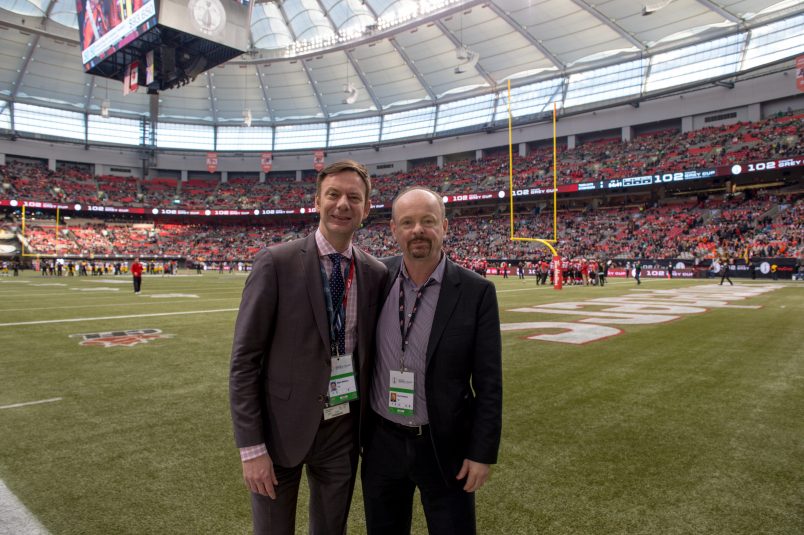CFL’s First Live-Audio Game Challenges the NFL’s Sound Supremacy
With six mics on the field, the faders stay open all game long on TSN
Story Highlights
Canada is coming around to on-field sound in a big way. The Canadian Football League (CFL), currently about halfway through its 2016 season, which will culminate in the Grey Cup event in October, broadcast on-field audio for the first time during a regular-season game, between the Calgary Stampeders and the Hamilton Tiger-Cats, shown on TSN last Sunday from Calgary’s McMahon Stadium.
However, unlike on-field audio for an NFL game, where the league controls the on-field audio signals from microphones on the teams’ centers, with audio “windows” limited around each snap of the ball, the on-field audio during this CFL game was on all the time. It came from six microphones — on both teams’ quarterbacks, backup quarterbacks, and coaches; was managed by the broadcaster with input from the league; and was available for the broadcast throughout the game, on a 10-second delay.
According to Paul Graham, VP/executive producer, TSN, the network had tried on-field audio twice before: for a PPV game nearly 20 years ago and during a preseason game five years ago. But this first-time use of on-field audio during a regular-season game is expected to be, well, a game-changer.
“[TSN] also carries the NFL in Canada, so you can easily make the comparison,” Graham says. “We wanted to close the gap, and then some. And we did.”
Network Control
TSN used Sennheiser lavalier microphones on the players. Audio came back to the production truck, where Graham was its first point of contact. He selected which mics were open, and the A1 added them to the program feed. In the truck control room was CFL VP, football operations, Kevin McDonald, who communicated with a censor operator in Toronto, who could mute any of the channels if necessary. Graham says three criteria were used for engaging the delay: foul language, the potential to divulge field strategies, and “excessive” abuse of officials.
Other guidelines included focusing on offensive players and muting the mics of any wired player not on the field. Of the six mic channels, Graham says, two or three were open at any time.
But they were open everywhere. Fans could hear huddle conversations right through to the snap and the follow-through of each play. “It’s really compelling to be able to hear the quarterback call the play in the huddle and hear the coaches react to it,” he says. “Viewers heard strategies evolve in real time on the field. “You knew when they were going to go for the two-point [conversion].”
In fact, the audio crew tried to be sensitive to potential audibles, quarterbacks’ changing called plays at the line of scrimmage. Graham says the teams could set up code words to use as cues to the mixers to mute the microphone.
In addition to the on-field audio, quarterbacks and coaches continued to use the encrypted, non-broadcast audio channels that both the CFL and the NFL have used for years for strategy.
The CFL’s on-field audio experiment comes during a season in which TSN and the league have agreed to enhance the broadcast sound. Several large-diaphragm Klover parabolic microphones were added to the sidelines this season to capture more field audio.
That’s a Wrap
TSN has been gathering CFL field audio for some time. The TSN weekly wrap show CFL30 uses sound from microphones worn by team receivers that’s recorded to a camera dedicated to following the wired players on the field and on the sidelines. Those microphones and receivers — Quantum 5X QT-5100 player mics sending sound to Lectrosonics SRC receivers — are supplied by Silent Sound Productions of Toronto, which also handles frequency coordination for the program and the league.
“Those microphones produce a lot of good audio, especially the players on the sidelines talking about plays and the game,” says Silent Sound owner Reynald Trudel. He adds that he and Quantum 5X executives have advocated for the league to use on-field audio during games and as part of replays.
Although no future games are scheduled to use this level of sound, Graham believes game-long on-field audio will become a routine part of the broadcast experience in the near future.
“We wanted to make a statement with the sound, and we feel we did,” he says. “The feedback we’ve gotten has been 99.9% positive, from the players and the fans. I can see this as being part of at least a game of the week.”

